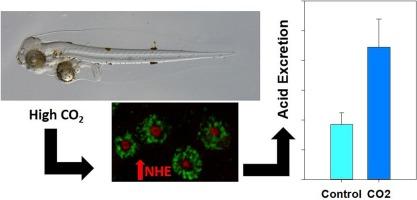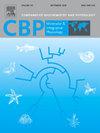The development and plasticity of acid excretion mechanisms in early life stage red drum, Sciaenops ocellatus
IF 2.2
3区 生物学
Q4 BIOCHEMISTRY & MOLECULAR BIOLOGY
Comparative Biochemistry and Physiology A-Molecular & Integrative Physiology
Pub Date : 2025-07-26
DOI:10.1016/j.cbpa.2025.111910
引用次数: 0
Abstract
Ocean acidification (OA) has been shown to affect early life stage fishes in a variety of ways, including reduced survival and growth, and increased tissue damage. Yet, there is also substantial interspecies variability in the sensitivity of early life stage fishes to high CO2, and it has been theorized that this may relate to the ontogeny of systemic acid-base regulatory pathways; an area that has been surprisingly understudied in obligate marine species. Here, we used an integrative set of approaches to describe the development and plasticity of acid excretion pathways in developing red drum (Sciaenops ocellatus), a marine fish native to the Gulf of Mexico. We observed mRNA expression of relevant transporters and ionocytes immediately post-hatch (36 h post-fertilization, hpf) with relatively stable abundance throughout the pre-metamorphic stages. Consistent with work in adults and seawater acclimated euryhaline larvae, we demonstrate strong co-localization of acid excretion proteins within a single epithelial ionocyte cell-type. Measurements of epithelial Δ[H]+, an indicator of proton efflux, showed that by 72 hpf larvae had CO2-responsive EIPA-sensitive acid excretion, confirming the presence of sodium proton exchanger (NHE)-mediated acid excretion. Elevated mRNA expression of nhe2 and nhe3 was induced following exposure to 5500 and 12,000 μatm CO2, which coincided with the absence of further survival effects relative to lower dose CO2. Overall, these data confirm that red drum have fully functional epithelial acid excretion pathways in early life, and that plasticity in these pathways may offer survival benefits.

红姑鱼早期酸排泄机制的发育与可塑性。
海洋酸化(OA)已被证明会以各种方式影响鱼类的早期生命阶段,包括降低生存和生长,增加组织损伤。然而,在早期生命阶段的鱼类对高CO2的敏感性上也存在大量的物种间差异,理论上这可能与系统酸碱调节途径的个体发生有关;这一领域对专性海洋物种的研究令人惊讶地不足。在这里,我们使用了一套综合的方法来描述发育中的红鼓鱼(Sciaenops ocellatus)的酸排泄途径的发育和可塑性,红鼓鱼是一种原产于墨西哥湾的海鱼。我们观察到相关转运体和离子细胞的mRNA表达在孵化后立即(36 h后受精,hpf),在整个前变质阶段相对稳定的丰度。与在成虫和海水驯化的广盐碱幼虫中的研究结果一致,我们证明了酸排泄蛋白在单一上皮离子细胞类型中具有很强的共定位。对上皮细胞Δ[H]+(质子外排指标)的测量表明,到72岁时,hpf幼虫有二氧化碳响应的eipa敏感酸排泄,证实了钠质子交换剂(NHE)介导的酸排泄的存在。暴露于5500 μatm和12,000 μatm CO2后,诱导nhe2和nhe3 mRNA表达升高,与低剂量CO2相比,没有进一步的生存影响。总的来说,这些数据证实了红桶在生命早期具有完全功能的上皮酸排泄途径,并且这些途径的可塑性可能提供生存益处。
本文章由计算机程序翻译,如有差异,请以英文原文为准。
求助全文
约1分钟内获得全文
求助全文
来源期刊
CiteScore
5.00
自引率
4.30%
发文量
155
审稿时长
3 months
期刊介绍:
Part A: Molecular & Integrative Physiology of Comparative Biochemistry and Physiology. This journal covers molecular, cellular, integrative, and ecological physiology. Topics include bioenergetics, circulation, development, excretion, ion regulation, endocrinology, neurobiology, nutrition, respiration, and thermal biology. Study on regulatory mechanisms at any level of organization such as signal transduction and cellular interaction and control of behavior are also published.

 求助内容:
求助内容: 应助结果提醒方式:
应助结果提醒方式:


